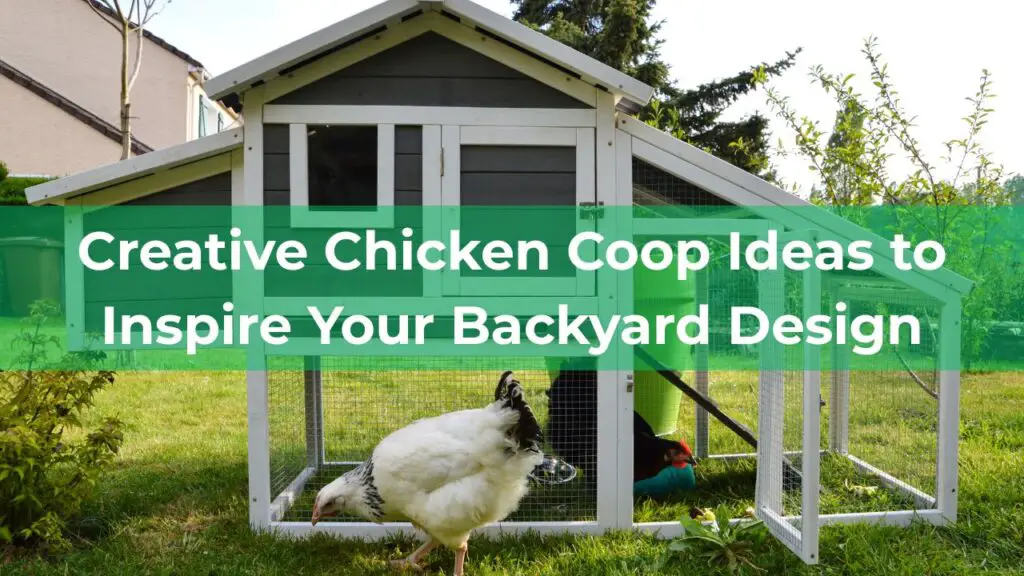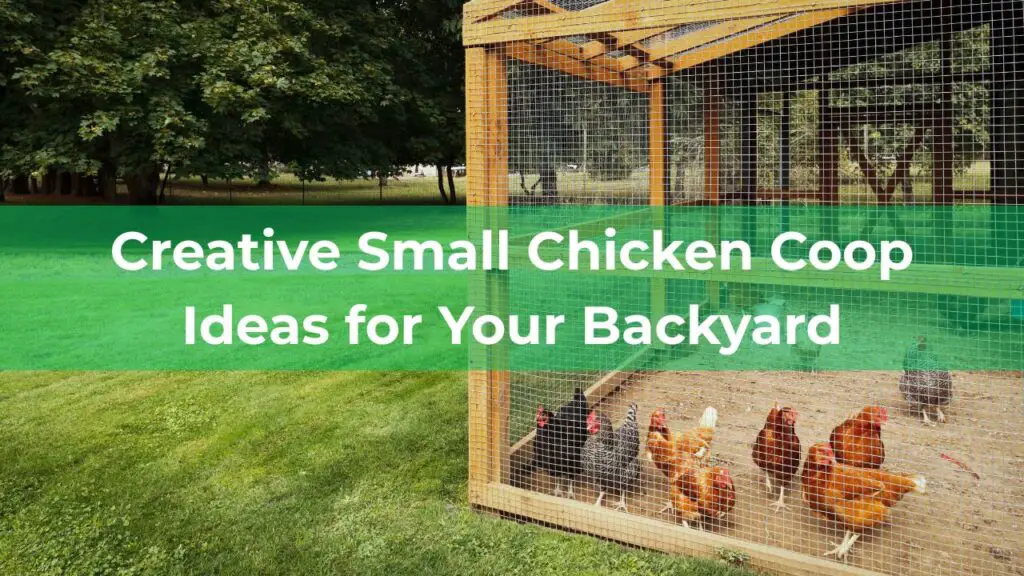Landscape design is all about creating beautiful and functional outdoor spaces that reflect your style and meet your needs. From planning layouts to selecting plants, it’s a hands-on process that can transform any backyard, garden, or park into a welcoming haven. Whether you have a small patio or a sprawling estate, effective landscape design can enhance your environment and make it more enjoyable for everyone.
Outdoor Lighting Solutions
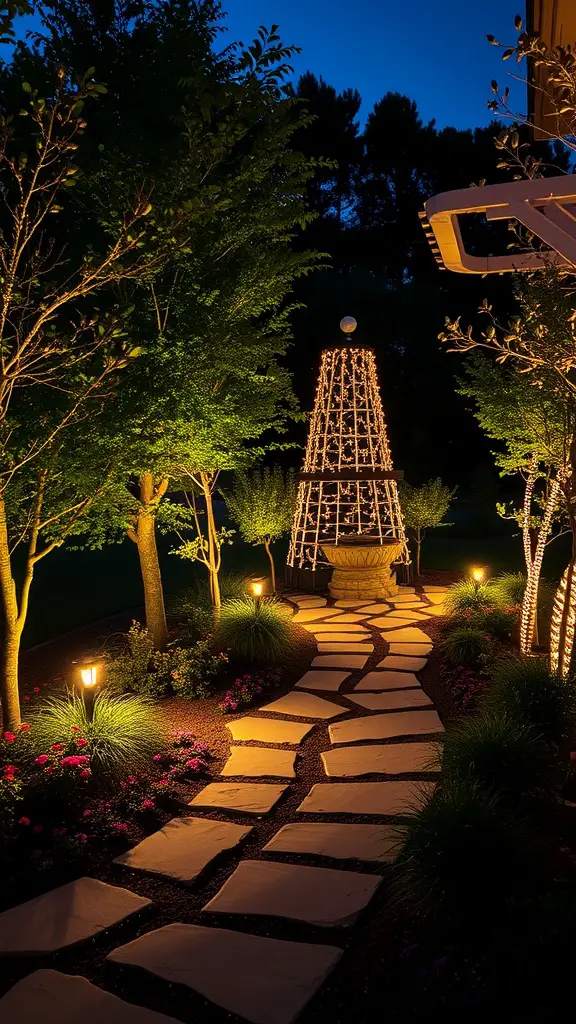
Outdoor lighting can completely change the look and feel of your garden. The image shows a beautifully lit pathway that invites you to explore. Soft lights along the path create a warm and welcoming atmosphere.
The centerpiece of this design is a decorative structure adorned with lights. It adds a touch of charm and serves as a focal point. The surrounding trees are subtly illuminated, enhancing their natural beauty.
Using different types of lighting can highlight various features in your garden. Spotlights can draw attention to plants or sculptures, while pathway lights ensure safety and visibility. This combination creates a balanced and inviting outdoor space.
Consider using energy-efficient LED lights for a sustainable option. They not only save electricity but also last longer. With the right lighting, your outdoor area can be enjoyed even after the sun goes down.
Water Features and Their Impact
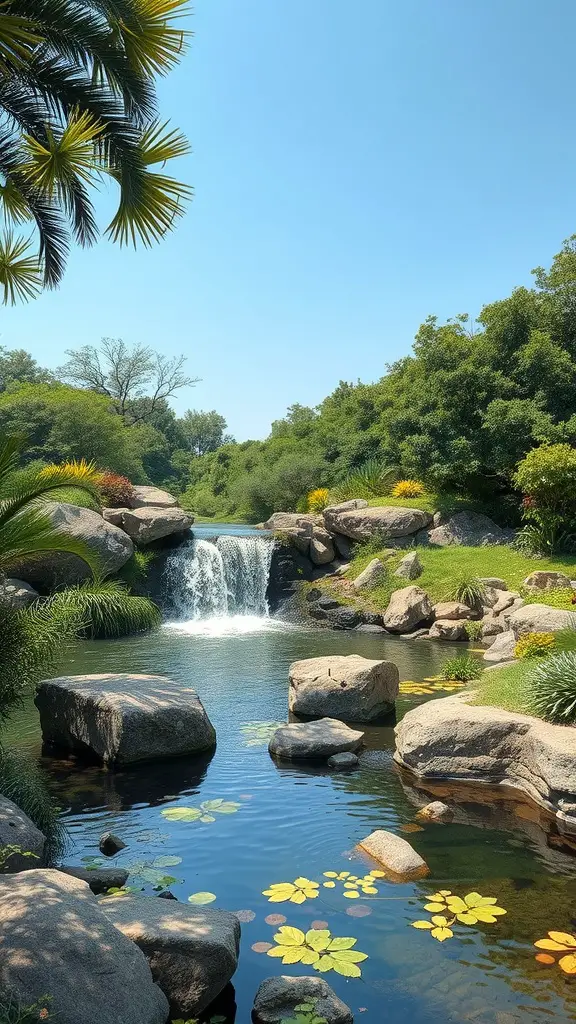
Water features can transform any outdoor space into a peaceful retreat. The image shows a serene scene with a waterfall cascading into a calm pond. This natural beauty invites relaxation and reflection.
Waterfalls create soothing sounds that can drown out noise from nearby streets or neighbors. The gentle flow of water can calm the mind and enhance the overall atmosphere of a garden. Adding plants like water lilies around the pond adds color and life, making the space even more inviting.
Moreover, water features attract wildlife. Birds, frogs, and beneficial insects are drawn to the water, creating a lively ecosystem. This not only enhances the beauty of the area but also contributes to a balanced environment.
Incorporating a water feature into your landscape design can also increase property value. Many homebuyers appreciate the tranquility that a pond or waterfall brings. It’s a unique element that sets a property apart from others.
Creating Functional Outdoor Spaces
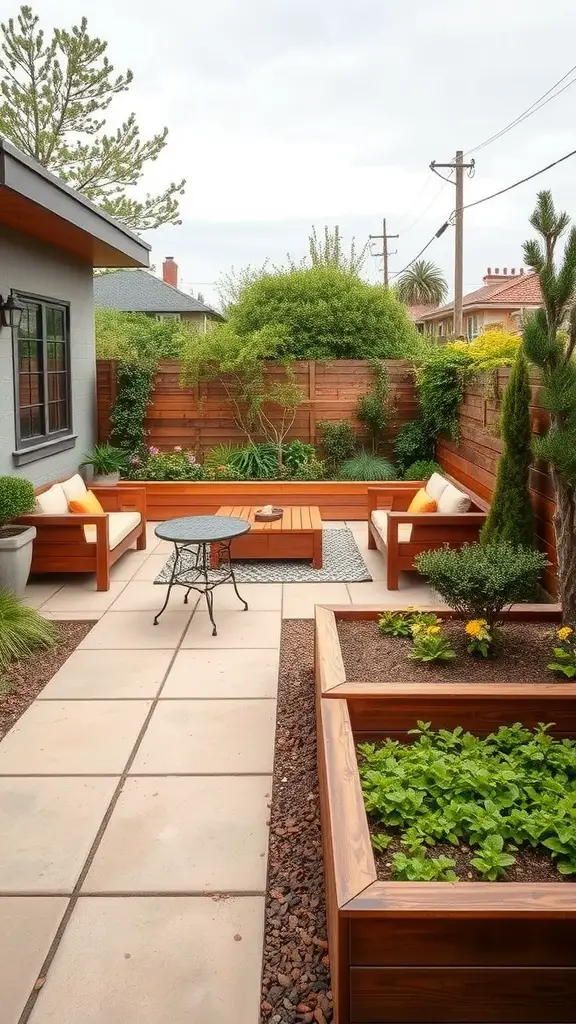
Outdoor spaces can be more than just a patch of grass. They can be inviting areas where you relax, entertain, or enjoy nature. The image shows a well-designed patio that highlights how to create a functional outdoor space.
The seating area features comfortable couches with bright cushions, making it a perfect spot for gatherings. The coffee table in the center invites casual conversations over drinks or snacks. Surrounding the seating, you can see planters filled with vibrant plants, adding life and color to the space.
The layout is practical, with a clear pathway leading to the seating area. This design encourages movement and makes it easy to navigate. The use of different materials, like stone and wood, adds texture and interest, making the space feel warm and welcoming.
Incorporating greenery not only beautifies the area but also contributes to a calming atmosphere. The mix of plants can attract butterflies and birds, enhancing the outdoor experience. This design shows how thoughtful landscaping can turn a simple yard into a functional retreat.
Incorporating Native Plants
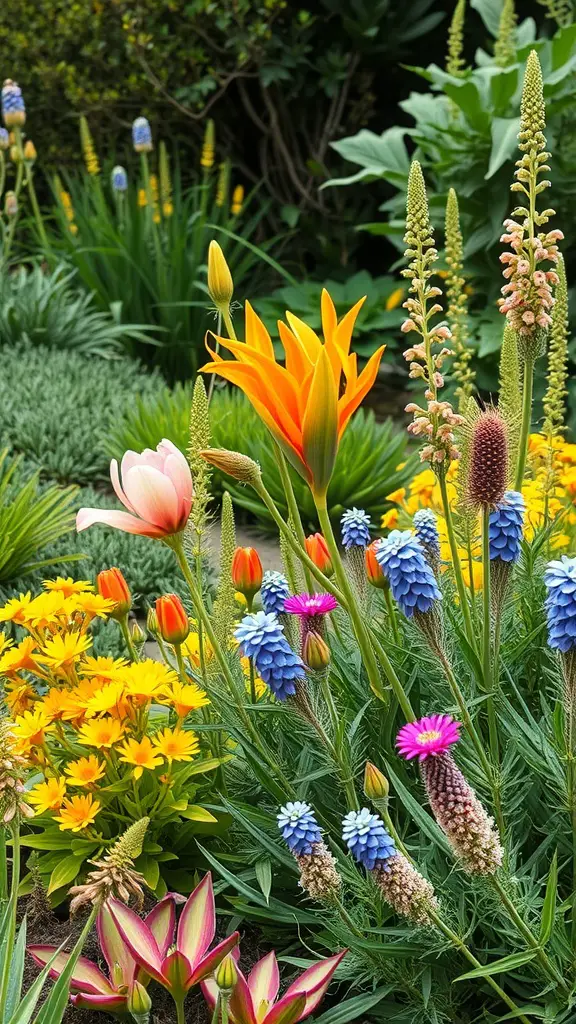
Native plants bring a unique charm to any landscape. The image showcases a vibrant mix of flowers, including bright orange blooms and cheerful yellow daisies. These colors create a lively atmosphere, perfect for attracting pollinators like bees and butterflies.
Using native plants in your garden is a great way to support local wildlife. They are adapted to the local climate and soil, which means they often require less water and maintenance. The plants in the image, with their diverse shapes and colors, highlight how beautiful a native garden can be.
Incorporating these plants not only enhances your outdoor space but also promotes biodiversity. Each flower plays a role in the ecosystem, providing food and habitat for various creatures. Plus, they can thrive in your garden without the need for chemical fertilizers or pesticides.
So, if you’re thinking about landscaping, consider adding some native plants. They can create a stunning visual display while benefiting the environment. The flowers in this image are a perfect example of how nature can inspire beautiful design.
Sustainable Landscape Practices
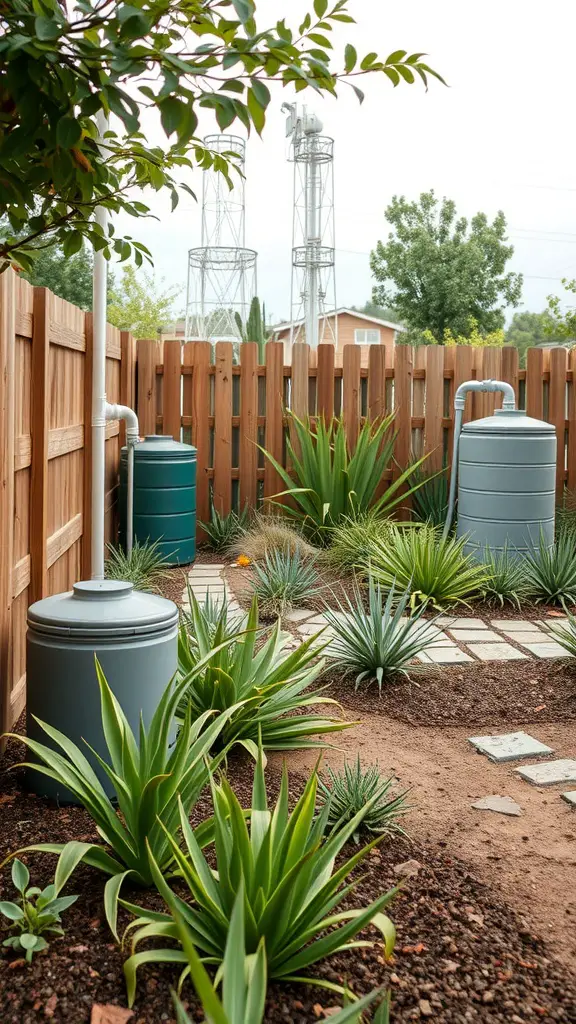
Sustainable landscaping is all about creating beautiful outdoor spaces while being kind to the environment. The image shows a well-designed garden featuring rainwater collection systems. These systems are practical and help conserve water, making them a smart choice for any landscape.
The green tanks in the image are not just functional; they blend nicely with the surrounding plants. Using native plants, like the ones seen here, reduces the need for excessive watering and maintenance. This approach supports local wildlife and creates a thriving ecosystem right in your backyard.
Another great aspect of this design is the use of stone pathways. They provide a natural look while allowing rainwater to seep into the ground, promoting healthy soil. Plus, they make it easy to navigate the garden without damaging the plants.
Overall, this landscape design showcases how sustainable practices can enhance both beauty and functionality. It’s a perfect example of how we can enjoy nature while protecting it.
Seasonal Color Schemes
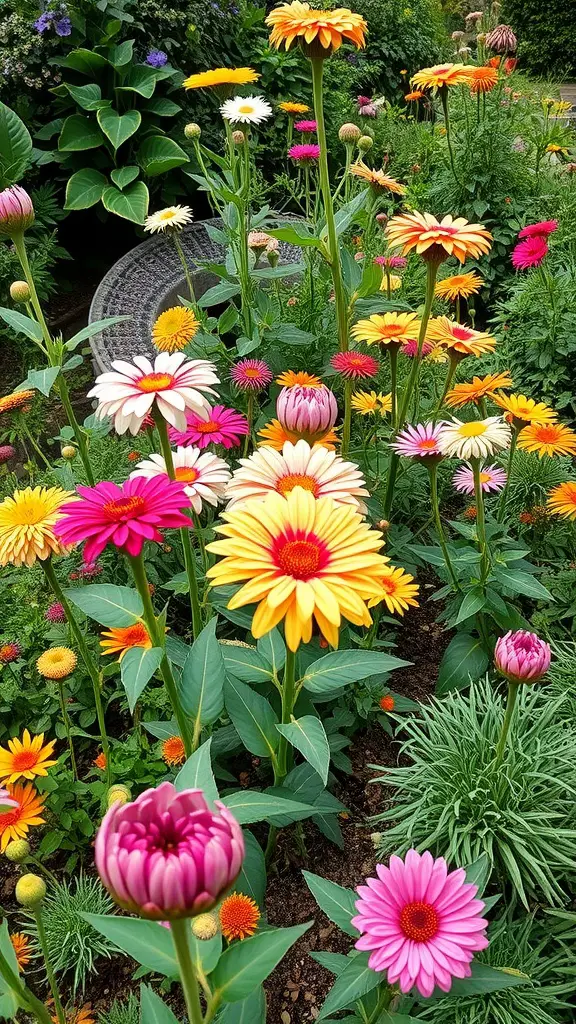
When it comes to landscape design, seasonal color schemes can bring a garden to life. The image shows a vibrant mix of flowers, showcasing bright yellows, pinks, and oranges. These colors not only attract the eye but also create a joyful atmosphere.
In spring and summer, using bold colors like those in the image can make your garden feel lively and inviting. Flowers like gerbera daisies and zinnias are perfect for this. They bloom beautifully and add a splash of color to any space.
As seasons change, consider how different colors can evoke various feelings. For example, warm tones can create a cozy vibe in fall, while cool colors like blues and purples can bring calmness in winter. Mixing these colors thoughtfully can enhance the overall design of your outdoor space.
Vertical Gardening Techniques

Vertical gardening is a fantastic way to maximize space while adding greenery to your environment. The image showcases a stunning vertical garden filled with various plants, creating a lush and vibrant display. This technique not only beautifies a space but also improves air quality and provides a unique focal point.
In the image, you can see an array of plants arranged on a vertical structure. The use of pots and a grid-like support allows for a diverse selection of plants, from trailing vines to leafy greens. This setup is perfect for small spaces, balconies, or even indoor areas where floor space is limited.
To create your own vertical garden, start by choosing a suitable wall or frame. Select plants that thrive in your local climate and consider their light requirements. Herbs, succulents, and flowering plants can all work well in a vertical setup. Make sure to use lightweight pots and a sturdy support system to ensure everything stays secure.
Watering can be a bit tricky, so consider a drip irrigation system or self-watering pots to keep your plants hydrated. Regular maintenance, like pruning and checking for pests, will keep your vertical garden looking its best. With a little creativity, you can turn any wall into a green masterpiece!
The Role of Hardscaping
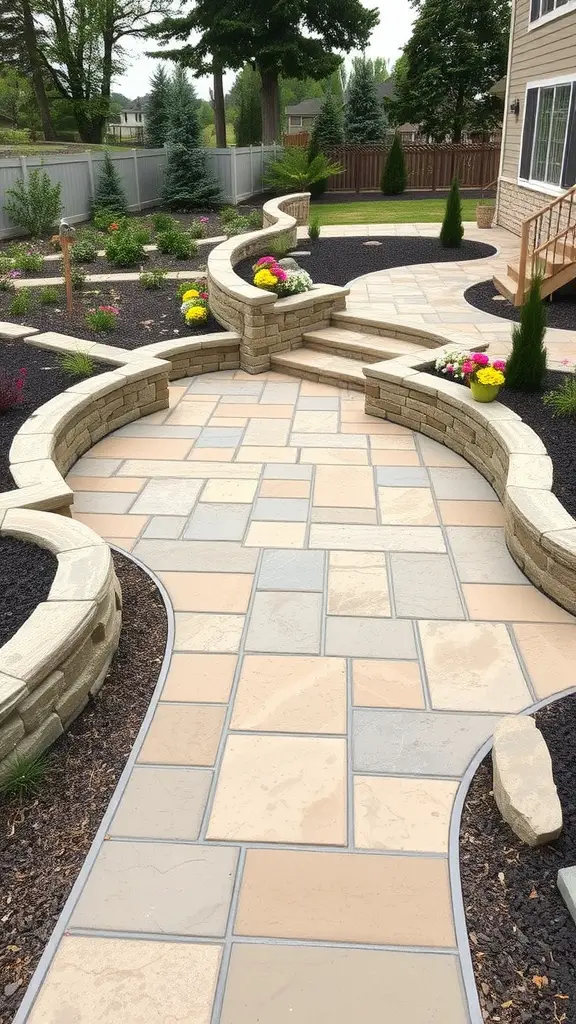
Hardscaping is a key part of any landscape design. It includes all the non-plant elements that create structure and functionality in outdoor spaces. In the image, you can see a beautifully designed patio area with stone pathways and seating walls. These features not only enhance the look of the garden but also provide practical spaces for relaxation and gatherings.
The stonework in the image is a great example of how hardscaping can define areas within a yard. The winding paths invite exploration, while the raised seating areas offer a perfect spot to enjoy the scenery. Using materials like stone and concrete can add durability and style to your outdoor environment.
Moreover, hardscaping helps manage water drainage and soil erosion. The carefully laid stones create a stable surface that can handle rainwater, preventing puddles and mud. This functional aspect is essential for maintaining a beautiful garden.
Incorporating hardscaping elements can also reduce maintenance needs. With less grass to mow and fewer plants to care for, homeowners can enjoy their outdoor spaces without the constant upkeep. The combination of hardscaping and landscaping creates a balanced and inviting atmosphere.
Pathway and Walkway Design
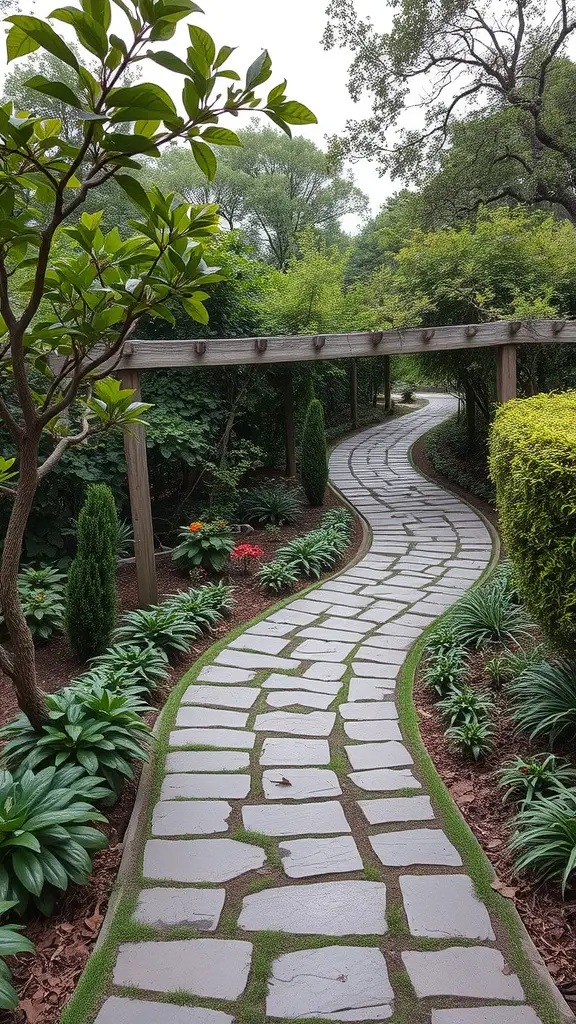
Creating a beautiful pathway can really enhance any outdoor space. The image shows a lovely winding path made of stone, surrounded by lush greenery. This design invites you to explore the garden while enjoying the natural beauty around you.
The stones are laid out in a way that feels organic, almost like the path has always been there. The grass peeking through the gaps adds a soft touch, making the walkway feel welcoming. This kind of design encourages a leisurely stroll, perfect for enjoying a quiet moment outdoors.
Adding plants along the edges can also create a sense of enclosure, making the space feel cozy. The mix of textures from the stones and foliage adds visual interest, drawing the eye along the path. Whether you’re designing a small garden or a larger landscape, thoughtful pathway design can make a big difference.
Creating Privacy with Landscaping
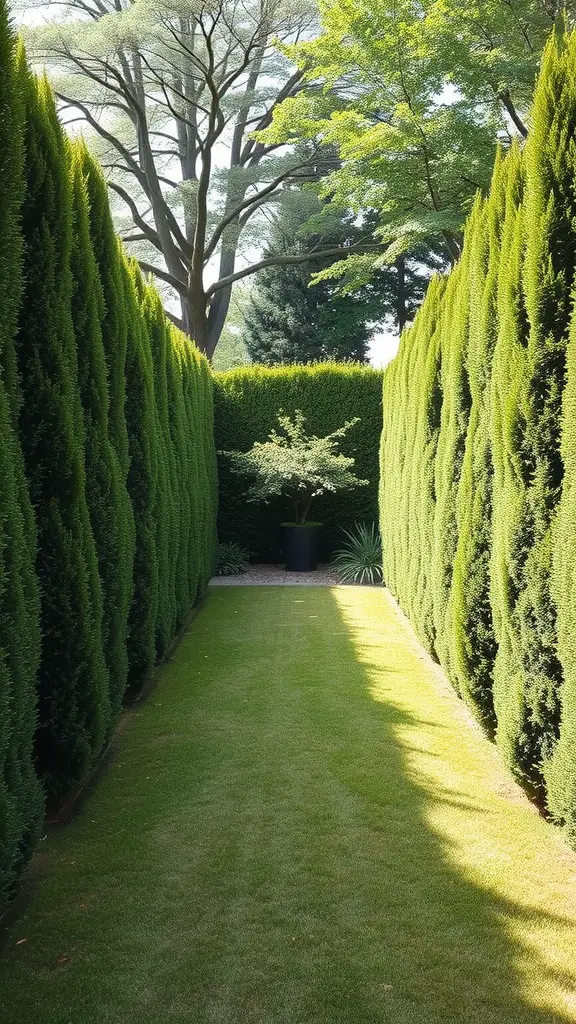
Creating privacy in your outdoor space can be a game changer. The image shows a narrow pathway lined with tall, lush greenery. These plants act as natural barriers, giving a sense of seclusion. The vibrant green hues invite you to explore further.
Using hedges or tall plants is a simple way to block out unwanted views. They create a cozy atmosphere, making your garden feel like a personal retreat. The neatly trimmed hedges in the image highlight how well-maintained landscaping can enhance privacy.
Incorporating features like planters or decorative elements can add character to your space. The small tree in the center of the pathway adds a focal point, breaking the uniformity of the hedges. This balance between structure and nature is key to effective landscape design.
Don’t forget about the ground cover! The soft, green grass in the image complements the tall plants, creating a harmonious look. A well-kept lawn can enhance the overall feel of your private space, making it inviting and relaxing.
The Importance of Soil Health
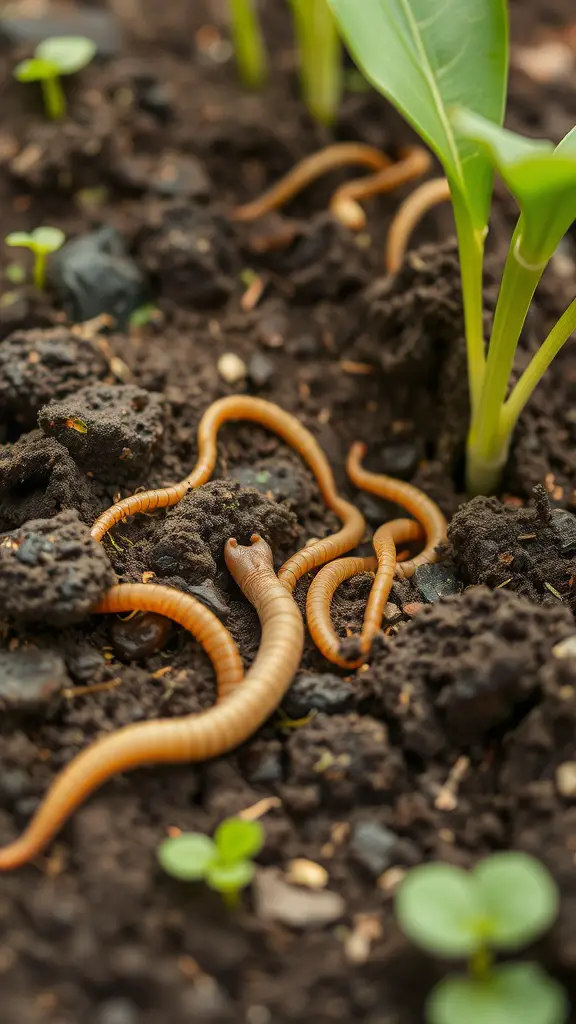
Soil health is a key player in landscape design. The image shows rich, dark soil teeming with life. You can spot several earthworms wriggling through the dirt, which is a great sign of healthy soil. These little creatures help aerate the ground and break down organic matter, making nutrients available for plants.
Healthy soil supports vibrant plant life. In the image, you can see young plants sprouting, thriving thanks to the nutrients provided by the soil and its inhabitants. This connection between soil and plants is essential for creating beautiful landscapes.
When designing a landscape, it’s vital to pay attention to soil quality. Good soil leads to strong plants, which in turn create a lush and inviting environment. So, whether you’re planting a garden or landscaping a yard, remember that healthy soil is the foundation of your success.
Designing for Wildlife
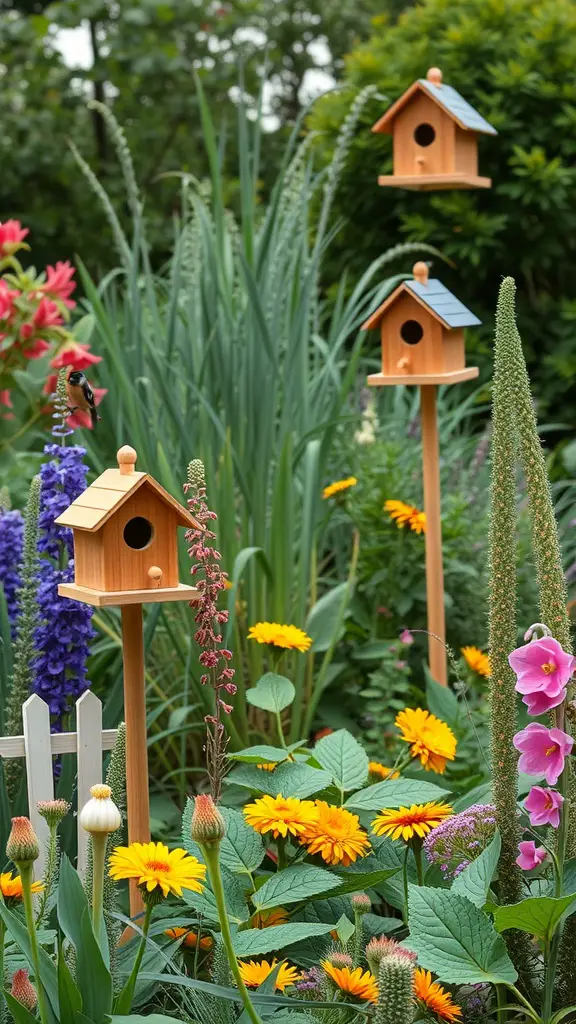
Creating a space that welcomes wildlife is a rewarding part of landscape design. The image shows a vibrant garden filled with colorful flowers and charming birdhouses. These birdhouses are not just decorative; they provide essential homes for birds, encouraging them to visit and thrive in your garden.
Flowers like the bright yellow ones in the foreground attract pollinators such as bees and butterflies. This helps create a balanced ecosystem. The tall green plants in the background offer shelter and protection for various creatures, making the garden a safe haven.
Incorporating elements like birdhouses and diverse plants can enhance your outdoor space. It invites nature right to your doorstep, allowing you to enjoy the sights and sounds of wildlife. Plus, it’s a great way to contribute to local biodiversity.
Balancing Hard and Soft Elements
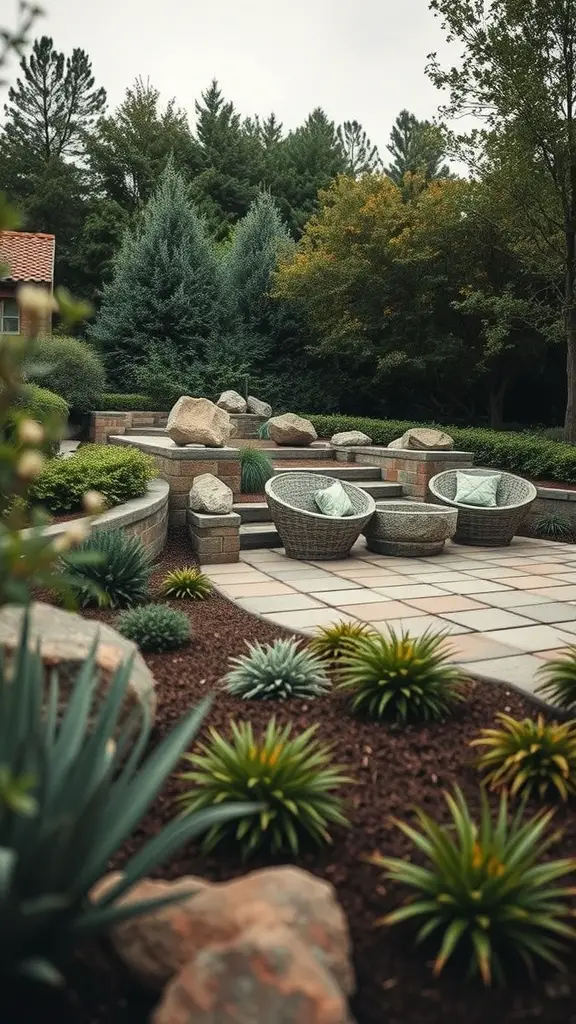
Creating a beautiful landscape is all about finding the right balance between hard and soft elements. In the image, we see a lovely outdoor space that perfectly illustrates this concept. The stone patio and seating area represent the hard elements, providing structure and a place to gather.
Surrounding these hard features are soft elements like lush plants and greenery. These plants soften the look of the stone and add a burst of life to the space. The mix of textures—from the smooth stones to the vibrant leaves—creates a welcoming atmosphere.
Notice how the arrangement of rocks and plants leads the eye through the landscape. This thoughtful placement encourages exploration and relaxation. It’s a reminder that a well-designed outdoor area can be both functional and inviting.
Incorporating both hard and soft elements not only enhances the visual appeal but also creates a space that feels balanced and harmonious. Whether you’re designing a backyard or a public park, this principle is key to achieving a stunning result.
Edible Landscaping Ideas
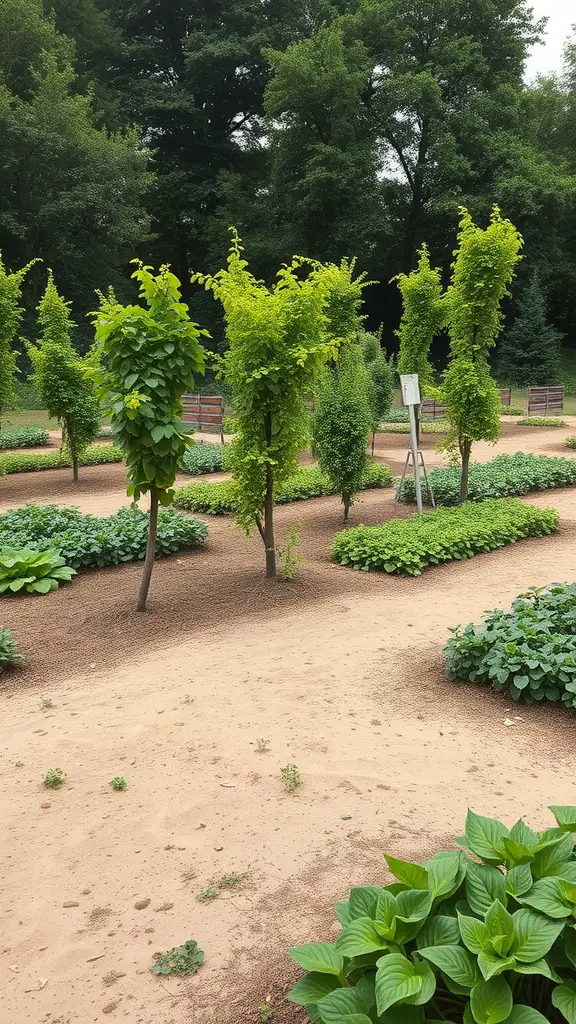
Imagine stepping into a garden where beauty meets utility. The image showcases a lovely landscape filled with vibrant greenery and neatly arranged plants. The unique shapes of the trees add character, while the surrounding beds of herbs and vegetables invite you to explore.
Edible landscaping is a fantastic way to bring fresh flavors right to your backyard. You can mix ornamental plants with edible varieties, creating a space that looks great and provides delicious produce. Think about incorporating herbs like basil or parsley alongside colorful flowers. This not only enhances the visual appeal but also offers fresh ingredients for your meals.
Consider using fruit trees as focal points. They can provide shade and beauty while yielding tasty fruits. Planting berry bushes in strategic spots can also add pops of color and attract pollinators. The key is to create a balance between aesthetics and functionality.
Don’t forget about ground cover! Plants like strawberries can spread beautifully while offering sweet treats. This approach makes your garden a feast for the eyes and the palate. With a little creativity, your edible landscape can become a delightful retreat.
Integrating Technology in Landscaping
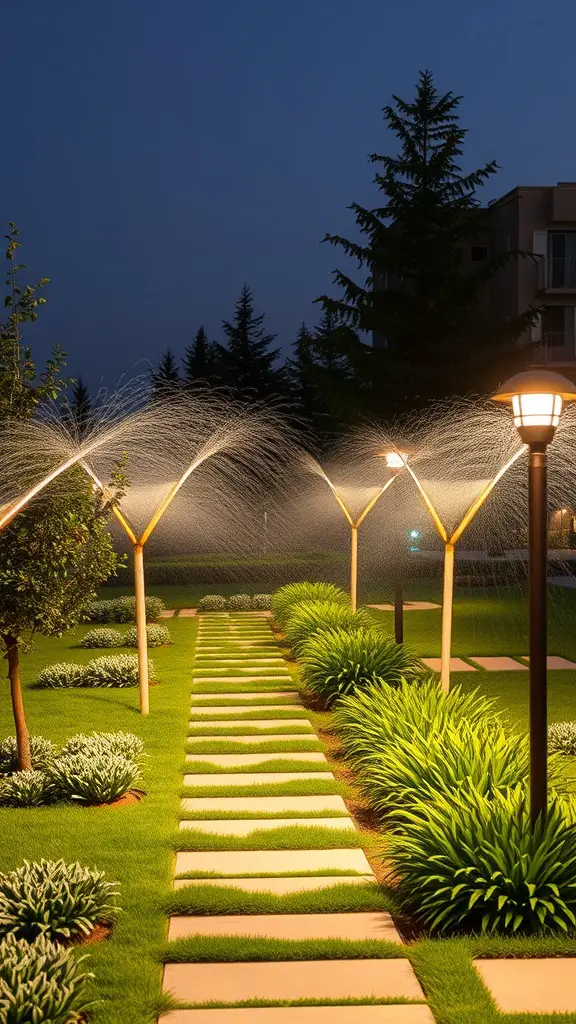
Imagine walking through a beautifully lit garden at night, where the path is lined with vibrant greenery and soft lighting. This image captures a stunning landscape design that uses technology to enhance the outdoor experience. The sprinklers create a gentle mist, adding a refreshing touch to the air while also keeping the plants healthy.
The combination of smart lighting and irrigation systems showcases how technology can elevate landscaping. These features not only beautify the space but also make maintenance easier. Automated sprinklers ensure that plants receive the right amount of water, while smart lights can be programmed to turn on and off at specific times, creating a welcoming atmosphere.
Integrating these technologies into landscaping is a smart choice for any homeowner. It allows for a more sustainable approach to garden care. With the right tools, you can enjoy a lush garden without the hassle of constant upkeep. This blend of nature and technology is a trend that is here to stay, making outdoor spaces more enjoyable and efficient.
Incorporating Outdoor Living Areas
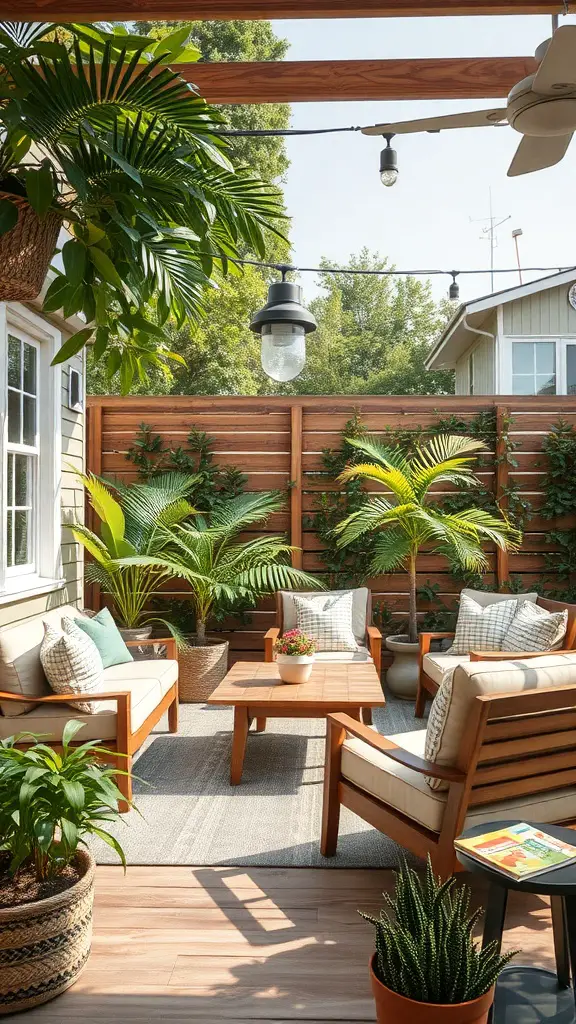
Creating an outdoor living area can truly enhance your home. The image showcases a cozy space filled with comfortable seating and lush greenery. This setup invites relaxation and social gatherings, making it a perfect spot for enjoying the outdoors.
The wooden furniture adds a warm touch, while the potted plants bring life to the area. The soft cushions make it inviting, encouraging you to sit back and unwind. String lights overhead provide a charming glow, perfect for evening gatherings.
Incorporating features like this into your landscape design can transform a simple backyard into a welcoming retreat. Think about how you can create your own outdoor oasis, whether it’s a small balcony or a spacious patio. Adding elements like comfortable seating, plants, and lighting can make all the difference.
The Impact of Climate on Design
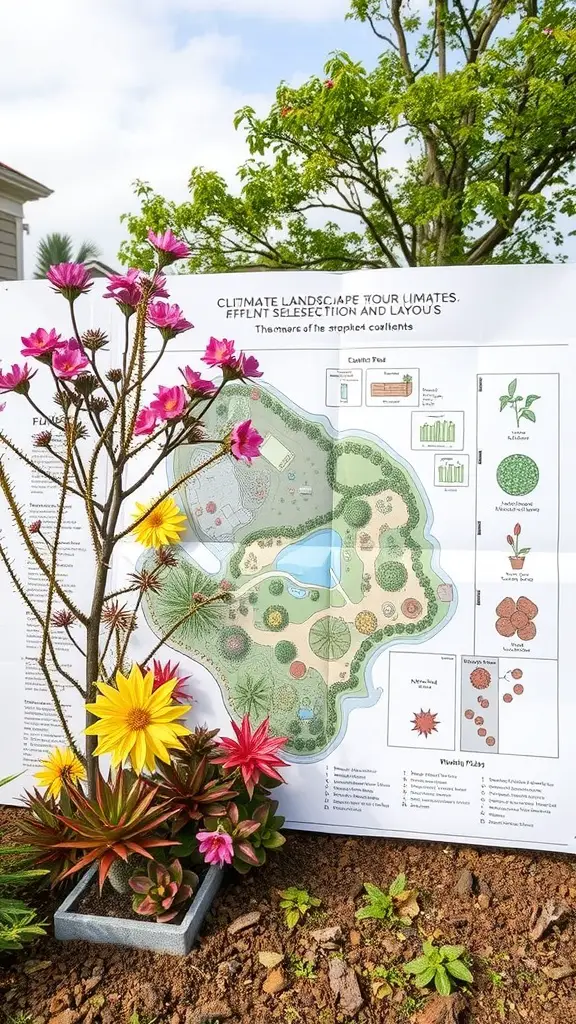
Climate plays a big role in how we design landscapes. The image shows a colorful plan that highlights different plants and layouts based on climate conditions. This is important for creating a space that thrives in its environment.
When choosing plants, it’s essential to consider their needs. Some plants love the sun, while others prefer shade. The layout in the image reflects this idea, showing how to group plants that will flourish together. This helps in maintaining a vibrant garden.
Water sources, like the pond in the plan, also affect plant choices. Plants near water can handle more moisture, while those further away might need to be drought-resistant. This balance is key to a successful landscape.
Lastly, the design must adapt to seasonal changes. The plan likely includes plants that bloom at different times, ensuring the garden looks good year-round. By understanding climate, we can create beautiful and sustainable outdoor spaces.
Utilizing Elevation Changes
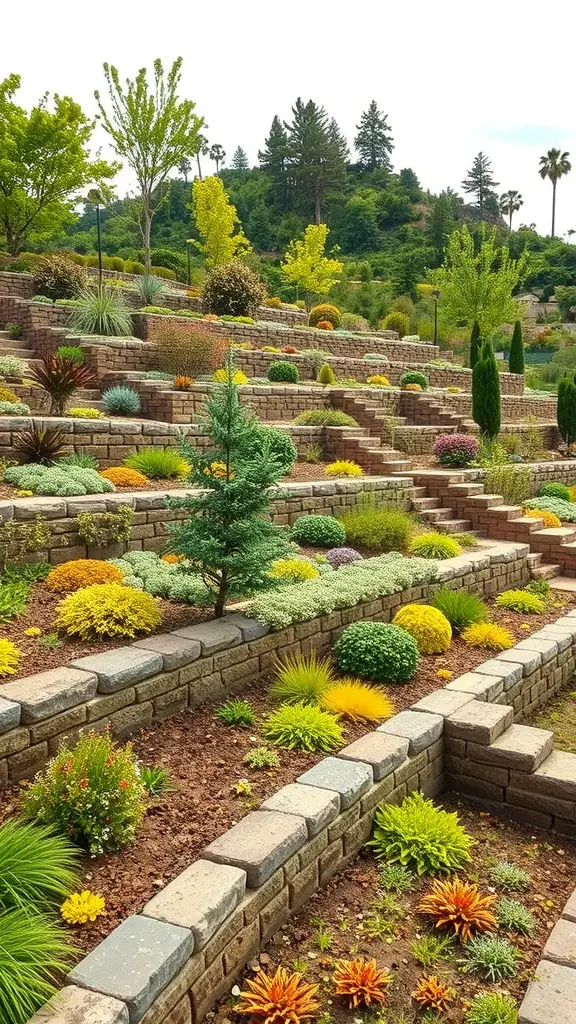
Elevation changes can add depth and interest to any landscape design. The image showcases a beautifully terraced garden, where different levels create a dynamic visual experience. Each tier is filled with a variety of plants, showcasing colors and textures that catch the eye.
Using elevation effectively can help define spaces in your garden. The steps and walls not only serve a practical purpose but also enhance the overall design. The arrangement of plants on each level allows for a layered look, making the garden feel lush and inviting.
Incorporating pathways and seating areas at different heights can encourage exploration. Visitors can wander through the garden, discovering new views and plants at every turn. This design approach makes the space feel larger and more engaging.
When planning your own garden, think about how you can use elevation to your advantage. Whether it’s a gentle slope or steep steps, changes in height can transform a flat area into a stunning landscape. Don’t be afraid to get creative with your design!
Designing for Small Spaces
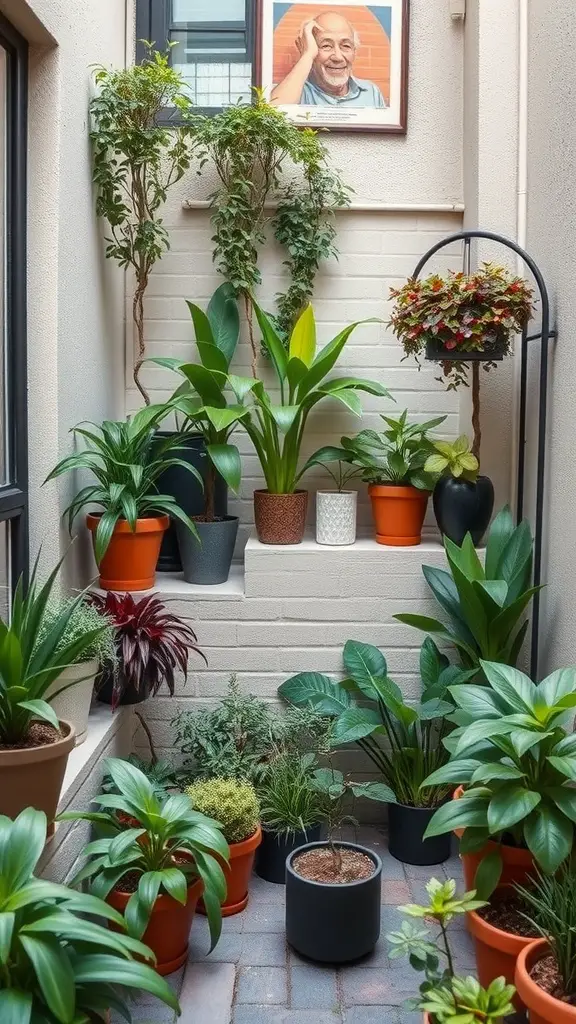
Small spaces can be a challenge, but they also offer a unique opportunity for creativity. The image shows a cozy corner filled with various plants, creating a vibrant atmosphere. This setup makes the most of limited space by using vertical and horizontal elements effectively.
Incorporating plants is a fantastic way to bring life into a small area. The mix of different pot sizes and colors adds visual interest without overwhelming the space. Notice how the taller plants draw the eye upward, making the area feel more open.
Using shelves or ledges can help utilize vertical space. The plants arranged on the steps create layers, which adds depth. This approach not only maximizes space but also creates a mini-garden feel.
Don’t forget about personal touches! The framed photo adds warmth and character, making the space feel inviting. Personal items can transform a small area into a reflection of your style.
Overall, designing for small spaces is about balance. With the right elements, you can create a beautiful and functional area that feels larger than it is.
The Use of Color and Texture
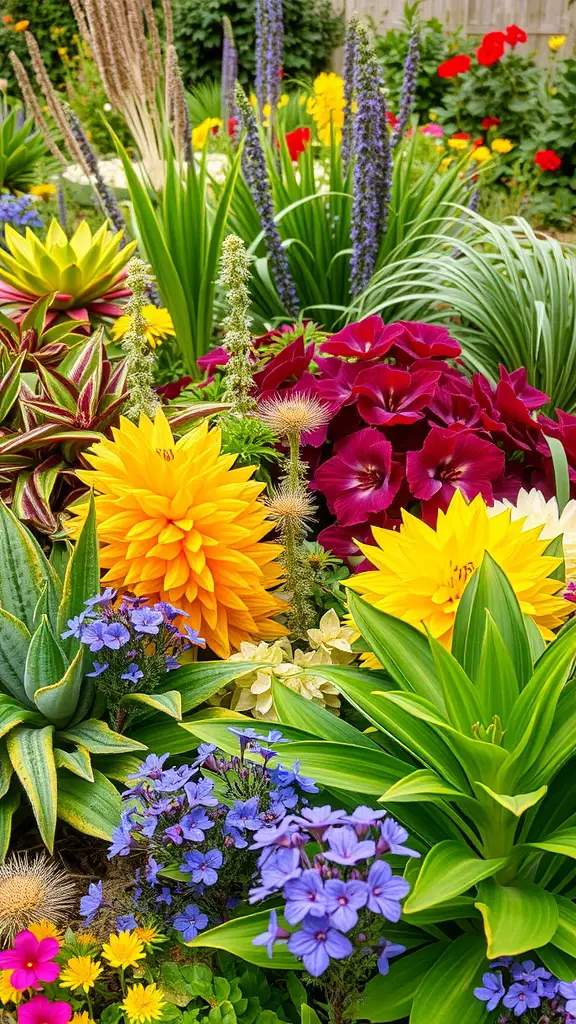
Color and texture play a big role in landscape design. They can bring a garden to life, making it feel vibrant and inviting. In the image, you can see a mix of bright yellows, deep reds, and calming blues. These colors create a lively atmosphere that draws the eye and lifts the spirit.
The textures in the image are just as important. The smooth petals of the flowers contrast beautifully with the spiky leaves of the plants. This variety adds depth and interest to the garden. When designing a space, combining different textures can make it more dynamic and engaging.
Using color and texture together can also help define areas within a garden. For example, bold colors can highlight a focal point, while softer hues can create a sense of tranquility. It’s all about balance and harmony in your design.
Overall, color and texture are essential tools in landscape design. They help create a space that feels alive and inviting, encouraging people to enjoy the beauty of nature.
Designing for Accessibility
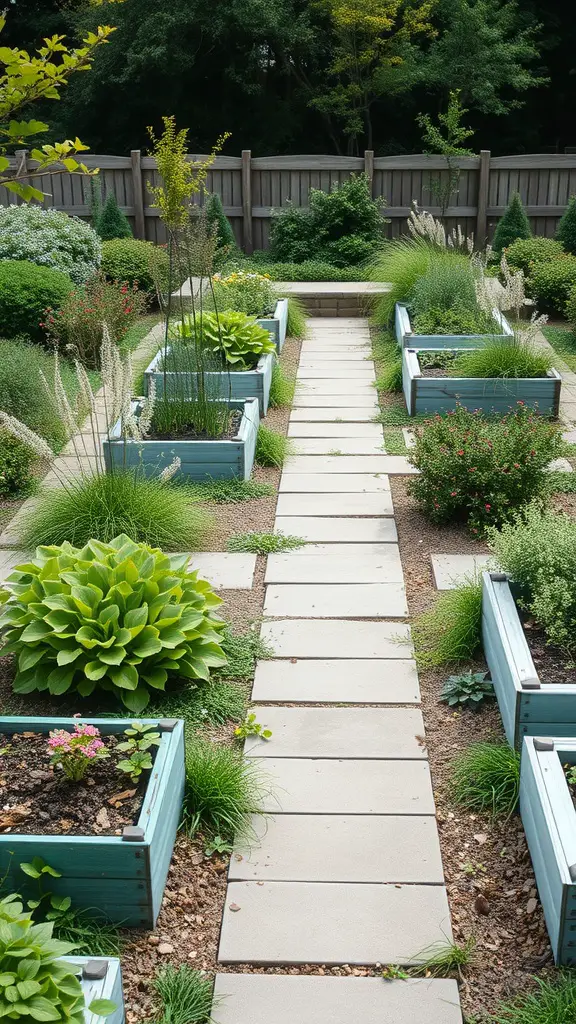
Creating a garden that everyone can enjoy is key to good landscape design. The image shows a well-planned garden with wide, clear pathways and raised planters. This setup makes it easier for people of all abilities to navigate and participate in gardening activities.
The use of raised beds is a smart choice. They allow individuals who may have difficulty bending down to reach the plants easily. This feature promotes inclusivity, ensuring that everyone can engage with the space comfortably.
Pathways are another important aspect. The wide, flat stones create a smooth surface for wheelchairs and strollers. This thoughtful design choice helps prevent accidents and makes the garden more inviting.
Incorporating a variety of plants adds visual interest and can stimulate the senses. The mix of colors and textures can be enjoyed by all, making the garden a delightful place to visit.
Incorporating Fire Features
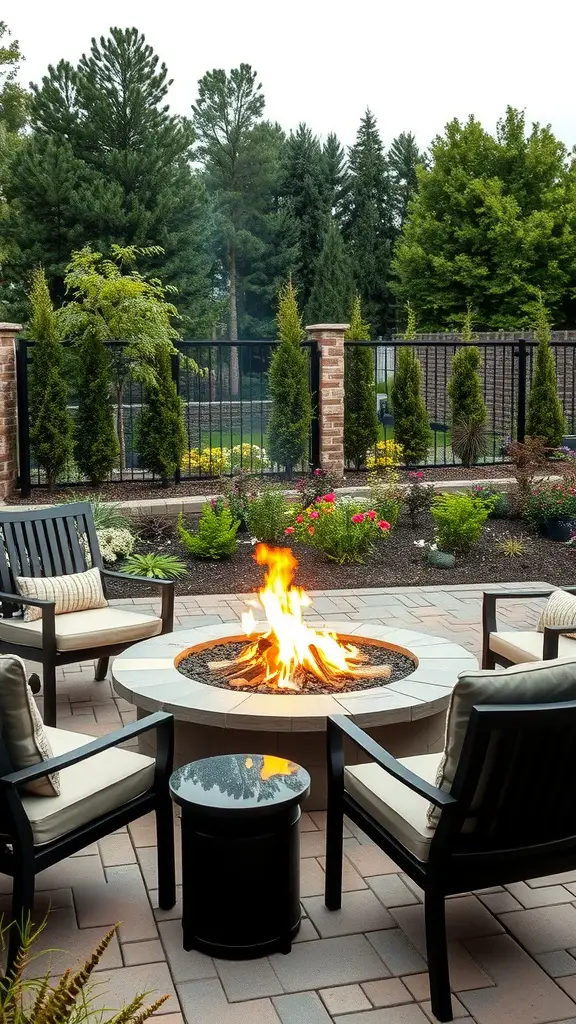
Fire features can truly transform a landscape. They create a cozy spot for gatherings and add a warm glow to outdoor spaces. In the image, we see a beautiful fire pit surrounded by comfortable seating. This setup invites friends and family to relax and enjoy evenings together.
The fire pit is the focal point here, drawing attention with its vibrant flames. It’s perfect for roasting marshmallows or sharing stories under the stars. The surrounding chairs offer a welcoming space, encouraging conversation and connection.
Landscaping around the fire feature is just as important. The greenery and flowers in the background enhance the natural beauty of the area. This combination of fire and nature creates a balanced atmosphere, making it a great place to unwind.
When planning your outdoor space, think about how a fire feature can fit in. It adds not just warmth but also a sense of gathering. Whether it’s a simple fire pit or a more elaborate setup, it can elevate your landscape design.
Seasonal Maintenance Tips
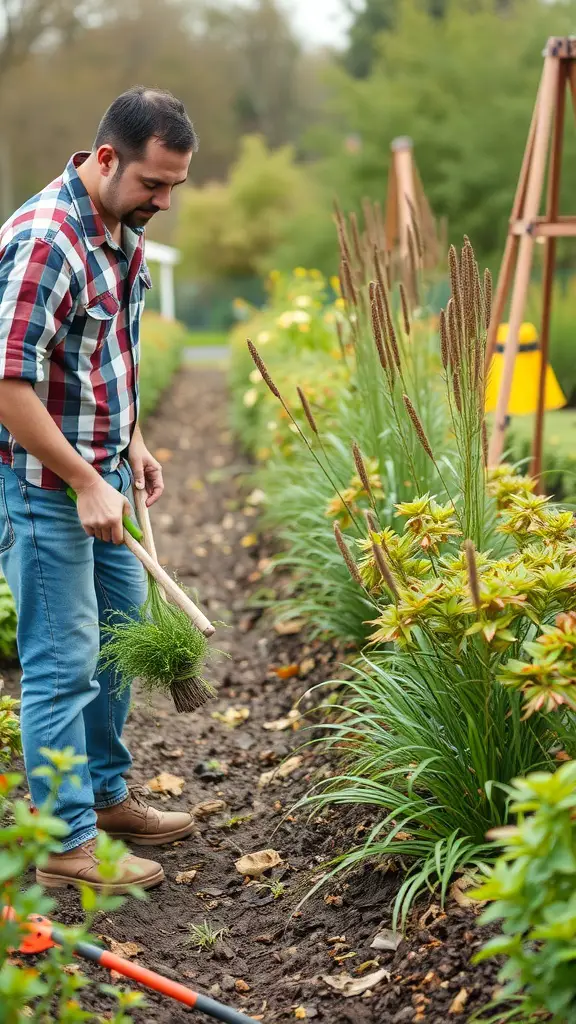
Maintaining a beautiful landscape requires attention throughout the year. In the image, we see someone actively engaged in gardening, which is a perfect example of seasonal maintenance. This hands-on approach helps keep plants healthy and vibrant.
During spring, focus on planting new flowers and shrubs. It’s a great time to remove any weeds that have sprouted over the winter. Regularly checking for pests is also key to keeping your garden thriving.
As summer rolls in, watering becomes essential. Make sure to water early in the morning or late in the evening to prevent evaporation. Pruning any overgrown plants will also encourage new growth and keep your landscape looking tidy.
When autumn arrives, it’s time to prepare for the colder months. Raking leaves and cleaning up debris will help prevent diseases in your plants. Consider planting bulbs that will bloom in spring, giving you something to look forward to.
Finally, winter is a time for rest. Protect your plants from frost by covering them or bringing potted plants indoors. This seasonal maintenance ensures your landscape remains healthy and beautiful year-round.
Creating Outdoor Pathways
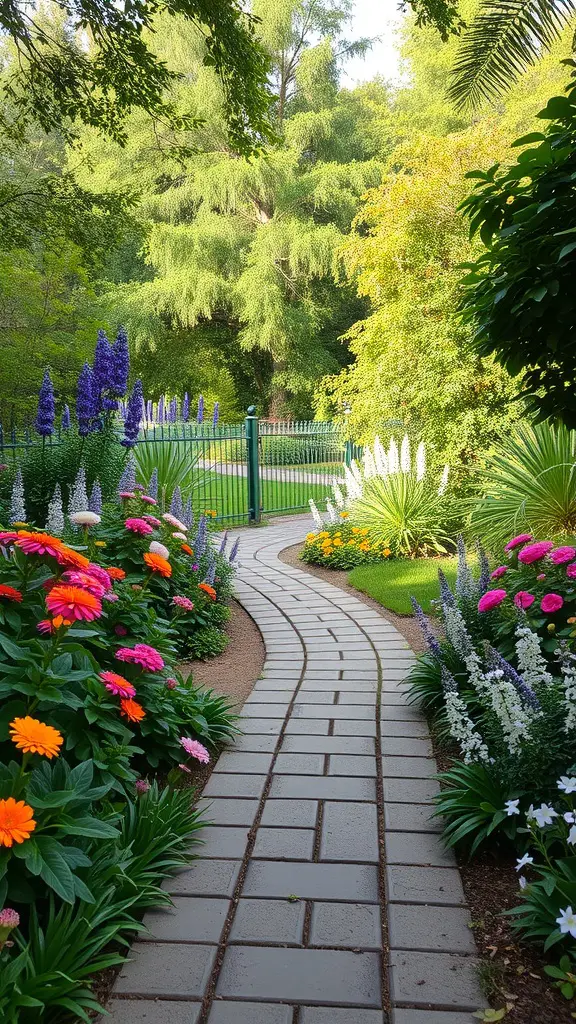
Outdoor pathways are more than just a way to get from point A to point B. They can transform your garden into a welcoming space. The image shows a lovely winding path, bordered by vibrant flowers and lush greenery. This kind of design invites you to stroll and enjoy the beauty around you.
When planning your pathway, think about the materials you want to use. In the image, the path is made of smooth stones, which adds a clean look. You can choose from bricks, gravel, or even wood, depending on the style you prefer.
Consider the shape of your pathway too. A curved path, like the one in the picture, creates a sense of mystery and encourages exploration. Straight paths can be more formal, but they might not have the same charm.
Adding plants along the sides, like the colorful flowers seen here, can enhance the experience. They not only add beauty but also attract butterflies and bees, making your garden lively.
Finally, lighting can make a big difference. Soft lights along the pathway can create a magical atmosphere in the evening. Think about how you want your outdoor space to feel, and let that guide your design choices.
Creating Cohesive Themes in Landscaping
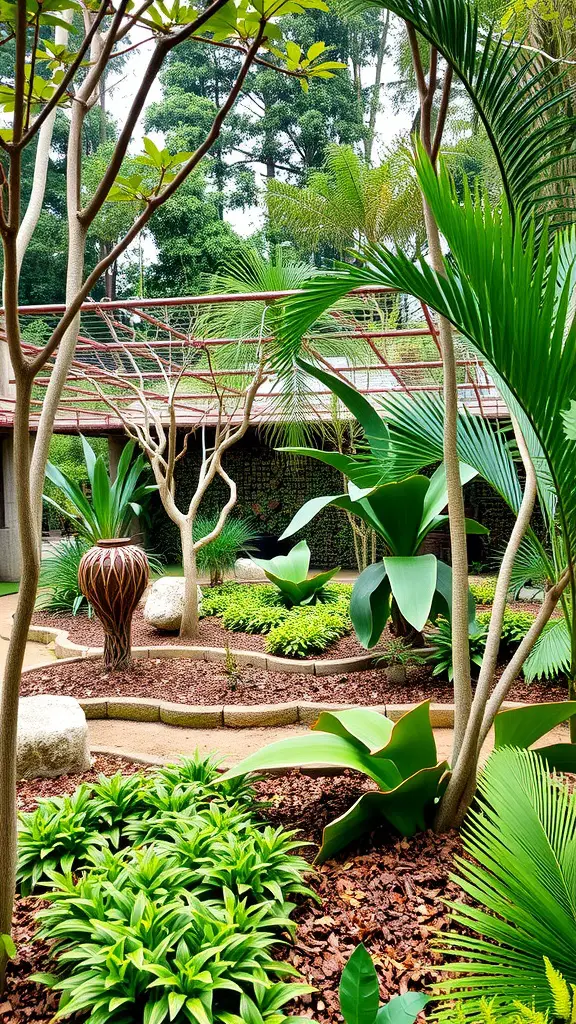
Creating a cohesive theme in landscaping can turn any outdoor space into a beautiful retreat. The image here showcases a well-thought-out design that blends various elements harmoniously.
Notice how the lush greenery is complemented by the unique textures of the plants. The combination of tall trees and broad leaves creates a layered effect, adding depth to the landscape. The use of natural materials, like the stone and wood, enhances the organic feel.
The central decorative pot adds a focal point, drawing the eye and inviting exploration. This element ties the surrounding plants together, making the space feel intentional and curated.
In landscaping, it’s important to think about how each piece interacts with others. The curves in the pathway guide visitors through the garden, encouraging them to appreciate the various plants and textures. This flow is essential for a cohesive theme.
Overall, this design illustrates how thoughtful landscaping can create a serene environment that feels both inviting and well-planned.
The Importance of Planning and Design
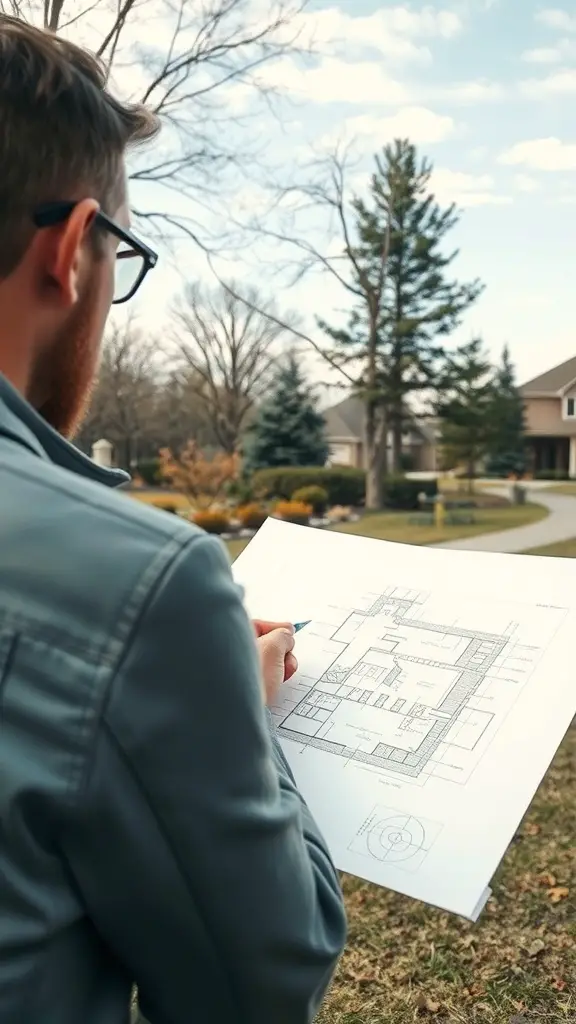
Planning and design are the backbone of any successful landscape project. When you look at the image, you see someone studying a detailed plan, likely for a garden or outdoor space. This careful examination shows the thought that goes into creating a beautiful and functional area.
Having a clear plan helps in visualizing the end result. It allows for adjustments before any physical work begins. This way, you can avoid costly mistakes and ensure that every element fits together harmoniously.
Designing a landscape isn’t just about aesthetics; it’s also about functionality. A well-planned space considers how people will use it. Will there be areas for relaxation, play, or gardening? These questions guide the design process.
Moreover, a good design takes into account the natural environment. Understanding the local climate, soil types, and existing plants can lead to a more sustainable landscape. This approach not only enhances beauty but also supports local wildlife.
In summary, planning and design are essential for creating a landscape that is both visually appealing and practical. By investing time in these stages, you set the foundation for a successful outdoor space.

